A History of the County of Worcester: Volume 3. Originally published by Victoria County History, London, 1913.
This free content was digitised by double rekeying. All rights reserved.
'Parishes: Redmarley d'Abitot', in A History of the County of Worcester: Volume 3(London, 1913), British History Online https://prod.british-history.ac.uk/vch/worcs/vol3/pp481-486 [accessed 23 April 2025].
'Parishes: Redmarley d'Abitot', in A History of the County of Worcester: Volume 3(London, 1913), British History Online, accessed April 23, 2025, https://prod.british-history.ac.uk/vch/worcs/vol3/pp481-486.
"Parishes: Redmarley d'Abitot". A History of the County of Worcester: Volume 3. (London, 1913), British History Online. Web. 23 April 2025. https://prod.british-history.ac.uk/vch/worcs/vol3/pp481-486.
In this section
REDMARLEY D'ABITÔT
Reode moere leage, Ryde mereleage (x cent.); Rydmer lege, Hrydmearlea, Ridmerleye (xi cent.); Rudmerleg (xiii cent.); Redmerley Dapetot (xiv cent.).
Redmarley D'Abitôt lies in the extreme south-west of the county on the Gloucestershire border. It covers an area of 3,800 acres, which includes 12 acres of inland water, 1,165 acres of arable land, 2,432 acres of permanent grass, and 89 acres of woods and plantations. (fn. 1) The soil is sand and clay on a subsoil of clay and shale and raises crops of wheat, beans, peas and barley. The parish is watered by the River Leadon, which divides Redmarley from Pauntley, (Gloucs.), on the south and by the Glynch Brook, (fn. 2) a tributary of the Leadon, and the Wynd Brook.
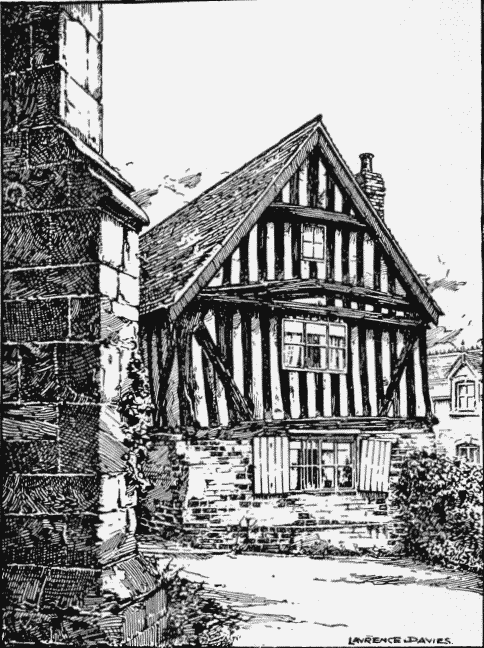
Church House, Redmarley D'Abitôt
The western part of the parish is hilly, rising from the valley of the Leadon to over 200 ft. above the ordnance datum. In the east the land is lower, standing at about 100 ft. above the ordnance datum. The main road from Ledbury to Gloucester passes through Redmarley. A branch from it to the west leads to the village, and another branch leads north-east across Glynch Brook to Pendock. The parish contains houses of various types and sizes scattered along several winding roads. In the south-west corner of the churchyard there is a 17th-century brick and timber house, and there are several other houses of this type in the parish, with large picturesque chimney stacks of red brick. The rectory lies about a quarter of a mile to the east of the church the present building occupying an old site which was originally moated.
At Bury Court Farm are the remains of a late 12th-century hall over a vaulted cellar, measuring 30 ft. by 17 ft. 8½ in. It is vaulted in three bays, with chamfered transverse and diagonal ribs springing from moulded corbels. In one side wall is a plain round-headed doorway, and close to it a small round-headed light. There are two similar lights in the opposite wall, now blocked by later additions. One end wall is also covered by modern buildings, but the other retains an original window. The hall door was reached by an outside stair; of the hall itself no original features remain.
There is a moated inclosure near Heart's Farm in the south of the parish.
In 1636 a certain John Jackman, yeoman, was indicted for obstructing the highway by erecting a pound in the road from Redmarley D'Abitôt to Tewkesbury. (fn. 3)
There are various notes in the registers of historic interest with regard to the parish. In the year 1644 'the battle of Redmarley,' in which between 2,000 and 3,000 troops were engaged, was fought among the fields outside the village. In the fight the Royalist leader Major - General Mynn was killed. (fn. 4) The name of Feargus O'Connor, Chartist agitator, is connected with the locality, and in 1847 the Lowbands estate was purchased by the National Land Company. Wakes were originally held on the village green (inclosed 1838) on the Sunday before St. Bartholomew's Day. (fn. 5)
Among the ancient place-names are Assendene (fn. 6) (xiv cent.); Le Mere, (fn. 7) Moreheldende or Morellynde (fn. 8) (surviving as Murrellsend) (xv cent.); Overhouse, The Held, Tondens, Slade, Neth Gramell, le Mort Medowe, Darcombe (fn. 9) (xvi cent.); Glasham, Howhill, Longeland, Thatchcroft (fn. 10) (xvii cent.).
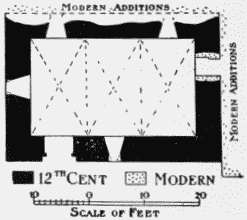
Bury Court: Plan of Vaulted Cellar
MANORS
Land at REDMARLEY belonged in the 10th century to the see of Worcester, a 'mansa' there 'near the Glynch Brook' being leased by Bishop Oswald in 963 for three lives to a certain thegn named Eadmær. (fn. 11) A similar lease was made by the same bishop to his thegn Æthelmund in 978. (fn. 12) Among the Worcester charters is one of Bishop Lyfing in 1038 dealing with land in Redmarley, (fn. 13) but the nature of the charter is not known.
Before the Conquest Azor and Godwine held Redmarley of the bishop's manor of Bredon, but by 1086, when it consisted of 7 hides, it had come into the possession of Urse the Sheriff. (fn. 14) The manor was still held of Bredon in 1299, (fn. 15) but the overlordship of the Bishops of Worcester is not mentioned after that time. Urse's interest passed to his descendants the Beauchamps, who continued as mesne lords until they acquired the manor at the beginning of the 15th century. (fn. 16)
In 1086 2 of the 7 hides of which the manor consisted were held under Urse by a certain William, (fn. 17) and subsequently the whole 7 passed to the D'Abitots, from whom the manor derived its name. Osbert D'Abitot held the manor about 1164–79. (fn. 18) The Geoffrey D'Abitot who held the manor early in the 13th century (fn. 19) was perhaps he who in 1204 gave 40 marks and a palfrey for having seisin of lands of which he had been deprived by the king's command. (fn. 20) His name also occurs in 1199 and 1200. (fn. 21) In 1241 Osbert D'Abitot released to Geoffrey D'Abitot all his claim in the manor of Redmarley. (fn. 22) This Geoffrey was perhaps succeeded by Ralph, for in 1274 it was said that the Earl of Gloucester had appropriated all the land belonging to Ralph D'Abitot and put it into his chase, and the land evidently lay in the neighbourhood of Redmarley, as the Glynch Brook is mentioned. (fn. 23) Probably, however, Ralph never held the manor, for it seems to have belonged in 1274 (fn. 24) to Geoffrey grandson of Geoffrey D'Abitot above mentioned. (fn. 25) He went in 1277 with William de Beauchamp Earl of Warwick against the Welsh, (fn. 26) receiving in the same year a respite for a few months from becoming a knight, (fn. 27) and three years later exemption for life from being put on assizes, juries and recognizances. (fn. 28) It was probably this same Geoffrey who in 1320 sued his uncle Geoffrey D'Abitot for a messuage and 2 carucates of land in Redmarley (evidently the manor) which the latter claimed by gift of his father Geoffrey. His nephew, however, stated that Geoffrey had been out of his mind when he made the gift, (fn. 29) and was apparently successful in proving his claim, for in 1321–2 he as Geoffrey son of John D'Abitot settled the manor on himself for life with remainder to John de Sapy and his wife Sibyl, daughter of Alice D'Abitot, Geoffrey's aunt. (fn. 30) Geoffrey evidently took an active part in the rebellion against the Despensers, and in 1321 a warrant was issued for his arrest as a 'rebel and enemy of the king.' (fn. 31) He was imprisoned at Gloucester, and only released after he had been obliged by 'force and duress' to give up the manor of Redmarley to Hugh le Despenser the younger, (fn. 32) who to make his title more secure obtained grants from the king (fn. 33) and from John de Sapy and Sibyl his wife. (fn. 34)
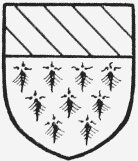
D'Abitot. Ermine a chief bendy or and sable.
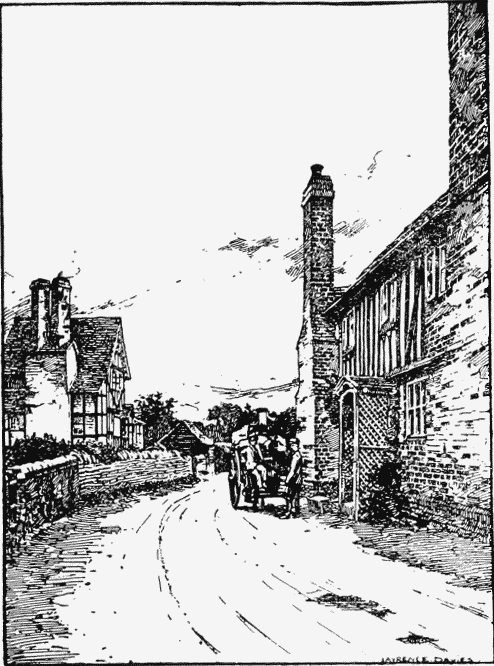
Street in Redmarley D'Abitôt
Immediately after the accession of Edward III John de Sapy and Sibyl received a grant of Redmarley in 'consideration of his losses in the service of the late king.' (fn. 35) This naturally led to quarrels with Geoffrey D'Abitot, who was probably among the 'malefactors' accused by John de Sapy of breaking his houses at Redmarley and taking away his goods. (fn. 36) Geoffrey petitioned in 1327 for a restoration of the manor, (fn. 37) but, although his lands were restored, (fn. 38) this manor does not appear to have been among them, and he was still trying to recover it in 1329. (fn. 39) He evidently did not succeed in establishing his claim, and in 1330 John de Sapy and Sibyl received a new grant of the manor for their lives only, (fn. 40) with a grant of free warren in 1332, (fn. 41) while in 1340 and 1342 the king confirmed the fine under which the manor had first been settled on them. (fn. 42) John de Sapy was knighted and received other marks of royal favour. (fn. 43) He was holding in 1346 (fn. 44) and died some time before 1350, when the fealty of his grandson John Sapy son of Thomas was taken for certain lands in Caldecot. (fn. 45) From the last-named John, (fn. 46) who was a justice of the peace for the county of Worcester, (fn. 47) and was still holding the manor in 1381, (fn. 48) it passed, probably by purchase, to Elizabeth widow of Edward Lord le Despenser, on whom it was settled in 1393. (fn. 49) She was succeeded in turn by her grandson Richard le Despenser, who died childless and while still a minor in 1414, (fn. 50) and by her granddaughter Isabel, through whose marriage with Richard Earl of Warwick (fn. 51) the manor came into the possession of the Earls of Warwick, who were already the overlords. It then followed the same descent as Elmley Castle (fn. 52) (q.v.), passing with it to Henry VII in 1487.
It was granted in exchange for other manors to Edmund Bonner, Bishop of London, in 1545. (fn. 53) Bishop Ridley, who succeeded Bonner, leased the park and a mill at Redmarley to his sister Alice and her husband George Shipside, (fn. 54) and they were living there when Bonner again became bishop on the accession of Queen Mary. Bonner wrote to Richard and Robert Lechmere requesting them to look after Redmarley and not to allow 'sheep's head or shipes side (alluding to Ridley's brother-in-law) to be any medler there or to sell or carry away anything from thence.' (fn. 55) Shortly afterwards he made a fresh lease of the park and mill to Thomas Sherle and others, but on the accession of Queen Elizabeth both park and mill were restored to the Shipsides. (fn. 56) In 1591 John, Bishop of London, surrendered the manor to the queen, (fn. 57) who immediately granted it in exchange for other lands to Thomas Crompton, Robert Wright and Gelley Meyrick. (fn. 58)
For a few years after this date the descent of the manor is not quite clear, but by 1612 it was in the possession of William Horton of the neighbouring parish of Staunton. (fn. 59) His son Thomas Horton sold it in 1615 to George Shipside's son George, (fn. 60) who had succeeded his father as lessee of the park and mill in 1609 (fn. 61) and was living at Redmarley in 1615. (fn. 62) After holding it for a year only, George Shipside, with Margaret his wife, sold the manor to a certain John Fleet, known also as Waldegrave, (fn. 63) but continued to live at the manor-house, then known as Redmarley Park. (fn. 64) John Fleet died at Hallow in 1619 and was succeeded by his son Thomas, (fn. 65) who died in the following year, leaving an infant son John. (fn. 66) The manor had been settled on Thomas and Jane his wife on their marriage in 1617. (fn. 67) She married secondly a certain William Bodenham, (fn. 68) whose name occurs on the Quarter Session Rolls as a recusant, (fn. 69) and also as refusing to contribute towards the repair of the roads in Redmarley. (fn. 70) Before 1676 the manor had been divided between Magdalen wife of Richard Williams and Anne wife of Ambrose Scudamore, (fn. 71) sisters and co-heirs of Thomas Fleet. They sold it to George Wellington of London, of whom it was purchased in 1698 by Sir Nicholas Lechmere of Hanley Castle. (fn. 72) It was in the possession of his great-grandson Edmund Lechmere in 1732 (fn. 73) and passed from him to his son Nicholas. (fn. 74) The latter, who took the name of Charlton in 1784, was succeeded by his son Edmund Lechmere Charlton, who was holding Redmarley in 1811. (fn. 75) He sold it in the following year to William Lord Beauchamp, (fn. 76) and it is now in the possession of William, the present earl.
A family named D'Abitot owned property in the parish in the 16th century, and lived at Down House. (fn. 77) According to Nash, the last member of the family died in the 18th century. (fn. 78)
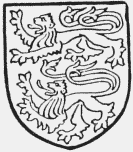
Lygon, Earl Beauchamp. Argent two lions passant gules with forked tails.
INNERSTONE
INNERSTONE (Inardestone, xiii cent.), now a farm in the parish, is first mentioned in 1229–30, when William de Kardiff conveyed a knight's fee there to Geoffrey D'Abitot. (fn. 79) Since that date it has always belonged to the lord of Redmarley. (fn. 80) It is called a manor until 1416, (fn. 81) and then apparently became merged in the more important manor of Redmarley.
The park at Redmarley is first mentioned in 1457. (fn. 82) It has always belonged to the lords of the manor, (fn. 83) various appointments of park-keepers being made by Edward IV (fn. 84) and Henry VIII. (fn. 85)
A mill in Redmarley worth 5s. 8d. is mentioned in the Domesday Survey. (fn. 86) In 1359 there was a mill known as Pauntleys belonging to the lord of Redmarley, (fn. 87) while in the 15th and 16th centuries there were two mills, one called Bury Mill, the other Flaxeorde Mill. (fn. 88) Bury Mill, Blackford Mill (fn. 89) and Farm Mill, on the Glynch Brook, are still in use. Besides the manorial mills the D'Abitots owned another mill called Thurbache, which John D'Abitot purchased from Thomas Bradford in 1549. (fn. 90) In 1654 Francis Dineley sued Thomas D'Abitot for detaining deeds relating to Thurbache Mill, claiming that the defendant had sold the reversion after his death to him, and afterwards leased the mill to him on condition that he would repair it. (fn. 91) It belonged to Charles Dineley and Frances his wife in 1685. (fn. 92) It was probably this mill which was owned by Edmund Cowcher in 1715. (fn. 93) There is at present a disused corn-mill called Durbridge Mill on the Leadon. In the 17th century the D'Abitots had the right of free fishing in the River Leadon, (fn. 94) which with Thurbache Mill passed from them to Charles and Frances Dineley. (fn. 95)
CHURCH
The church of ST. BARTHOLOMEW consists of a chancel measuring internally 28 ft. by 17½ ft., nave 49½ ft. by 23½ ft., a west tower 14 ft. square, a north aisle 16 ft. wide, a north vestry and a south porch. The whole church, with the exception of the tower, was rebuilt in 1855.
The east window of the chancel is of three lancet lights, and in the north and south walls are single lancets. The furniture includes a 17th-century credence table, two chairs (one dated 1632) and some 17th-century baluster altar-rails re-used in the quire desks.
The nave has a north arcade of three bays, and is lit by two-light window, all in the style of the 14th century.
The timber south porch and the octagonal stone font are both modern, as are also the arches to the chancel and tower. The two-light west window, with a four-centred head, is probably of 18th-century date.
The only monument of importance is that to George Shipside, who died in 1609, aged eighty-four, on the north wall of the chancel. It is a framed slab headed Memento Mori, with a rhyming epitaph.
The exterior of the tower is in three stages, with an embattled parapet and angle pinnacles; there is a stair at the north-west angle entered from the outside by a segmental-headed door. The belfry windows are of two lights and similar to the window in the west wall. The tower was rebuilt early in the 18th century, but the lower part is perhaps of earlier date. The roof of the church is tiled.
The bells are six in number, the first, second, fourth and fifth by Abel Rudhall, 1743, the third 1739 and the tenor 1793.
The plate consists of a cup and cover paten engraved with the date 1571; there are also a modern paten, flagon and almsdish.
The registers before 1812 are as follows: (i) baptisms 1542 to 1695, burials 1539 to 1691, marriages 1539 to 1693, and from these dates the entries are continued promiscuously to 1702; (ii) mixed entries 1703 to 1800, marriages extending to 1753; (iii) baptisms and burials 1800 to 1812; (iv) marriages 1755 to 1797; (v) marriages 1798 to 1812.
ADVOWSON
The first mention of the church of Redmarley occurs in 1290, when the Bishop of Worcester dedicated three altars there. (fn. 96) The advowson followed the same descent as the manor (fn. 97) (q.v.) until 1590, when the manor was granted to Thomas Crompton and the advowson retained by the queen. It belonged to the Crown (fn. 98) until James I granted it to William Teynton or Taunton in 1610. (fn. 99) The descent for some time after this date is not clear. William Teynton had been succeeded before 1662 by Henry Jackson, clerk, (fn. 100) in whose family the advowson remained until 1739, when Thomas Jackson and his wife sold it to Francis Morton. (fn. 101) The latter was the patron from 1745 to 1750, (fn. 102) but Michael Biddulph presented to the living in 1789 and George Monro in 1801. (fn. 103) Between 1829, when George Monro still owned the advowson, (fn. 104) and 1836 it was purchased by the Nibletts, (fn. 105) and is now in the possession of the rector, the Rev. Henry Morton Niblett.
The rector of Redmarley claimed among other liberties the right of pasturing eight oxen and two cows in all the demesne pastures of Redmarley and Innerstone and 'lawegrist' in all the mills of the lords, and these were confirmed to him by John Sapy, kt., in 1358. (fn. 106)
In the 15th century there was a chapel at Innerstone which was the cause of a dispute between the inhabitants of that place and the rector of Redmarley. It was decided in 1466 that the rector should find a chaplain to serve the chapel. (fn. 107) It seems to have been disused before the Dissolution, and its site may be marked by the present Chapel Farm.
At the time of the Dissolution there was a chantry dedicated in honour of our Lady in the church of Redmarley D'Abitôt. (fn. 108) It seems to have been founded by Walter D'Abitot and Thomas Mon' and others, but the foundation charter has not been found. (fn. 109) The parish then contained 230 'houseling people,' and the salary of the chantry priest, who was 'competently learnyd and of honest conversacon,' was derived from lands valued at £6 10s. 4d. yearly, (fn. 110) which were granted in 1549 to Thomas Watson and William Adys. (fn. 111)
A Bible Christian chapel was built about the middle of the 19th century for the Chartist colonists on the Lowbands estate, (fn. 112) and was afterwards used by Primitive Methodists. It was bought by the late Colonel Scobell in 1908, and is now used for church services and other purposes. There is a Wesleyan Methodist chapel near the village, erected in 1859 and rebuilt in 1889.
CHARITIES
The church and poor's land charities are regulated by scheme of the Charity Commissioners 24 April 1896. They comprise the five charities following, which were recorded on the church table, namely:—
1. John Bower, founded by deed 29 April 1462, consisting of a parcel of land known as Nottin Dole, toward the repair of the church and for the use of the poor.
2. Walter Ryley, by deed 11 December 1469, gave lands known as Carter's Close, Bean Pits, Bell Acre and two other pieces of land. (fn. 113)
3. An unknown donor gave several pieces of land containing about 2 acres, and there were other parcels of land given for charitable purposes.
The lands above referred to were sold in 1873 and the proceeds invested in £857 18s. 2d. consols with the official trustees.
4. William Church, will dated in 1727, being a rent-charge of 20s. issuing out of a tenement known as Church's, for putting out poor children to school, constituting the educational foundation of William Church.
5. Margaret Birchett, will dated in 1732, being a rent-charge of 10s. issuing out of a messuage known as The Folly. This money is given to four poor widows who are not in receipt of parish pay.
Also the charity of John Reginald Pindar Earl Beauchamp, founded by will proved in the P.C.C. 22 February 1853, trust fund £124 17s. consols with the official trustees. This includes a small investment from sale of timber.
By the scheme a moiety of the dividends of £857 18s. 2d. consols, amounting to £10 14s. 4d., is made applicable towards the repair and maintenance of the church, and the other moiety, together with the dividends on £124 17s. consols, amounting together to £13 16s. 8d., is distributed in coal. The rent of the post office, representing the old poorhouse, amounting to about £9 a year, is likewise distributed in coal.